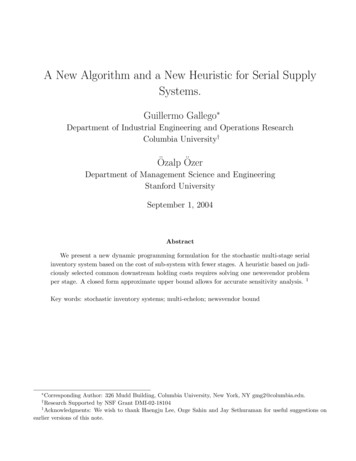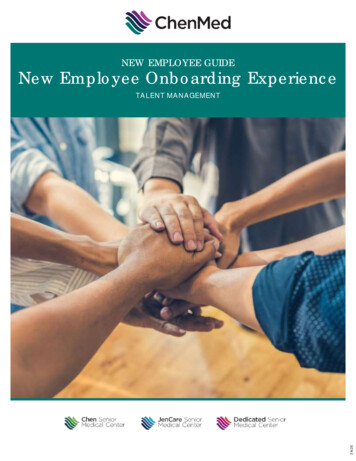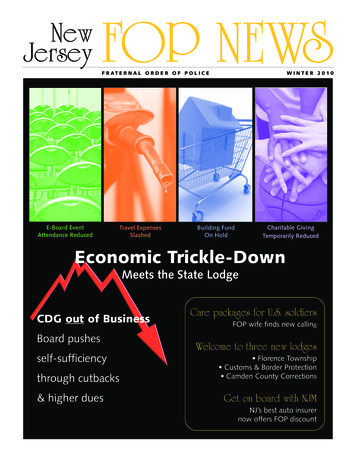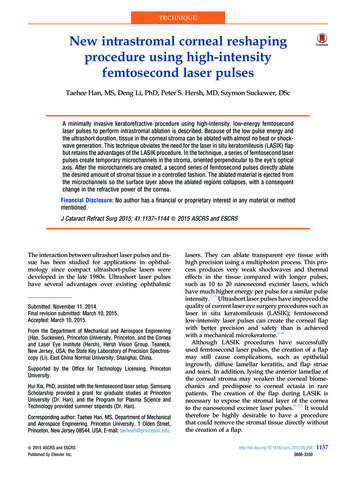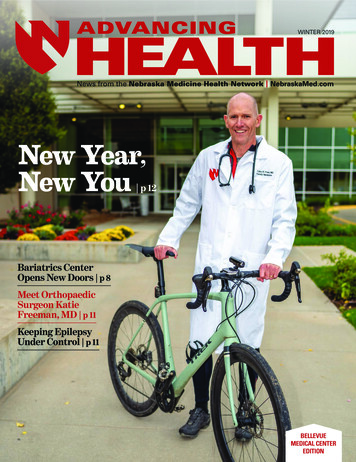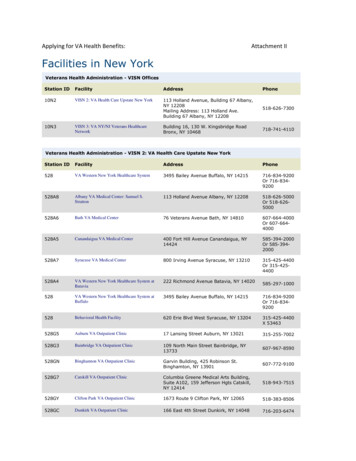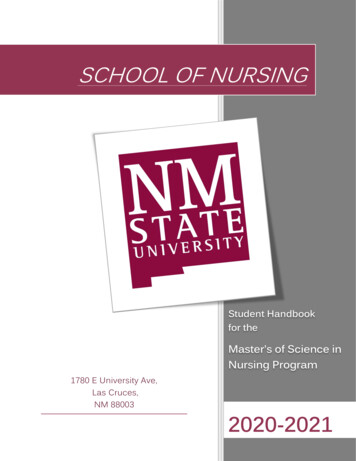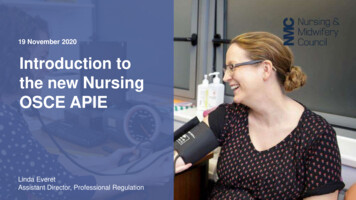
Transcription
19 November 2020Introduction tothe new NursingOSCE APIELinda EveretAssistant Director, Professional Regulation
Housekeeping Everyone, except the presenters, are automatically muted The “raise your hand” feature will not be used today Use the “?” feature or speech bubble to submit any questionsor comments at any time Audio-only participants can email questions and comments toToC@nmc-uk.org We may not be able to address individual points buteverything is being noted for consideration You can download the slides using the resource function The session will be recorded2
Today’s agenda9:00 amWelcome, scene setting and latest NMC updatesLinda Everet, Assistant Director, NMC9:05 amOverview of the OSCE designSarah Maughan, Director, AlphaPlus9:15 amExamples of APIE contentSarah Maughan, Director, AlphaPlus9:35 amSupport MaterialsSarah Maughan, Director, AlphaPlus9:40 amQ&A sessionJack Bland, Senior International Registration Manager, NMCLinda Everet, Assistant Director, NMCPenny Howard, Assessment Lead for Nursing, School of Health Sciences, The University of NottinghamSarah Maughan, Director, AlphaPlus9:55 amNext steps and closingLinda Everet, Assistant Director, NMC3
Previous webinars Over 300 people joined our first two webinars: Overview ofthe new Test of Competence and the new Computer BasedTest (CBT) Thank you to everyone who attended, asked questions andsubmitted feedback If you weren't able to join these webinars, you can watch therecordings and download the presentation slides on ourwebsite www.nmc.org.uk/registration/toc-review4
NMC Test of Competence: Nursing OSCE APIEAlphaPlus Consultancy Ltd.November 2020PartnershipQualityWe work in partnership with our clients. Thisis more than a cliché for us: we care aboutthe services we provide and the impact theyhave on learners. Experience has shown usthat the best impact our work can have iswhen it is undertaken alongside our clientsso we make partnership a key feature of ourproject approach and management method.We manage projects effectively and tothe highest quality, freeing up experts toconcentrate on their specialism, butensuring that activities are manage tomeet expectations. This means onlymaking promises that we know we cankeep, and remembering the promises wehave made to make sure we deliver.ExpertiseDevelopmentEducationalistsWe ensure our teams consist of genuinesector experts with understanding inbreadth and depth of both the theoryand the practical complex everydaychallenges faced by education providers.We are committed to the improvementof our staff, both to promote the longterm development of our business and asan end in itself: we believe in the value ofeducation for all.We are educationalists with a strongcommitment to improving teaching,learning and assessment, based onintellectual integrity, sound evidence andinnovative approaches.
Overview of OSCE design
The anningImplementationEvaluation An established means of assessing practical clinical practice Provides a means of assessing holistic practice – following apatient through their treatment by using a common scenario Used in current Test of Competence – some updates in the newTest to make it a better assessment of the new standards Some re-purposing of existing APIEs and some new scenarios
Format of the new test of competence: kOSCEFutureFormatSingle test of Part A: Numeracy120 questions Part B: Clinicallasting 3 hours6 stations10 stations4 station‘APIE’ Assessment Planning Implementation Evaluation4 station ‘APIE’ Assessment Planning Implementation Evaluation6 skill stations 2 pairs of 2 skills2 skill stations 1 professional values 1 critical appraisalMarks15100Timing30 minutes2 hours and 30 minutesVariable by stationaccording to taskspecific criteriaUp to 2 hours and 45minutesAPIE stations: Assessment station: 20 Planning station: 14 Implementationstation: 16 Evaluation station: 14Skills stations, criticalappraisal and professionalvalues stations: 16 minutes for eachpairing
Format of the new test of competence: kOSCEFutureFormatMarksTimingSingle test of 120 questionslasting 3 hoursPart A: Numeracy1530 minutesPart B: Clinical1002 hours and 30 minutes6 stations10 stations4 station ‘APIE’ Assessment Planning Implementation Evaluation4 station ‘APIE’ Assessment Planning Implementation Evaluation2 skill stations6 skill stations 2 pairs of 2 skills 1 professional values 1 critical appraisalUp to 2 hours and 45 minutesVariable bystationaccording totask-specificcriteriaAPIE stations: Assessment station: 20 Planning station: 14 Implementation station:16 Evaluation station: 10Skills stations, critical appraisal andprofessional values stations: 16 minutes for each pairing
The development processNMC OSCE Development Process FlowTriallingNMC cy.co.ukCAGAuthors QAPhaseAuthoring andQAAmendmentsAmendmentsCAG reviewAmendmentsAmendmentsAmendmentsCAG reviewTrials andanalysisReview / SignoffPlanning forintroductionReviewDeliveryDelivery
Test Design Multiple OSCE forms:www.alphaplusconsultancy.co.uk Fixed station grouping to ensure broadest possible coverage of standards andcomparability between different OSCEs Some overlapping skills stations between different OSCEs Candidates will resit the same station(s) if they fail New OSCE forms being added over time and new groupings of stations Assessors mark against a list of criteria: Demonstrated/ not demonstrated Demonstrated/ partially demonstrated/ not demonstrated Assessors also make a holistic judgement (to be used for standardssetting and monitoring) A set of red flags are also used for each station
OSCE overview: adult SubduralAnxietyHerniaAsthmaChronic cardiac failureEctopicCommunityFall and fractureHomelessnessKey:Re-purposed: least changesRe-purposed: significant changesNewPIESkill 1Skill 2Skill 3Skill 4Skill 5Skill s/bahaviourAppraisingevidencebasedpractice
OSCE overview: other fieldsAPIESkill 1www.alphaplusconsultancy.co.ukClinicalRN3: mentalhealthRN5: learningdisabilitiesRN8: children’sDepression andsuicide ideationBehaviours thatchallengeAsthmaRe-purposed, leastchangeRe-purposed,signifcant changeNewSkill 2ClinicalSkill 3ClinicalSkill 4ClinicalSkill 5Skill 6Professional Appraisingvalues/evidencebehaviours based practice
Examples of APIE content
Assessment: Candidate briefingPlease conduct a holistic assessment assessing the patient’s physical, psychosocial, spiritualand sexual care needs.As part of your assessment please complete an A – E assessment (Airway, Breathing,Circulation, Disability, Exposure), and take and record the patient vital signs (blood , pulse rate, oxygen saturations, respiratory rate) and calculate a National EarlyWarning Score 2 (NEWS2) score.Depending on the patient’s circumstances and condition you may wish to focus on some areasof assessment in more depth than others. Please note, a sheet of paper is provided so candidates can write notes The notes are not assessed (nor is the verbal input) – the completedNEWS2 is assessed
Patient OverviewName: Ash PotterDate of Birth: 01/01/1950 (70 years old in 2020)Address: 1 Sweet Street, WestshirePost Code: WW6 5PQGP: Dr Biswaz, The Plains Surgery, Westshirewww.alphaplusconsultancy.co.ukPresenting Complaint: Recalled following bowel screening and undergone a rigid sigmoidoscopy. Diagnosed with a small primary colorectal cancer. Undergone a laparoscopic hemicolectomy which was uncomplicated and no stomanecessary. Now attending the surgical assessment unit ten days after surgery with a 5cm woundat the surgical (extraction) site. The wound is inflamed with some exudate. Ash expresses feeling hot and more tired than usually. Reduced dietary and fluid intake since surgery and has not opened bowels for fourdays Feeling emotionally ‘low’ and expressing abdominal pain. Walked unaided before surgery, finding it more difficult due to abdominal pain.Past Medical History: Broken arm aged 8 Hypertension since 2005 Glaucoma since 2017Social History: Normally lives and cares for partner who suffers with slight cognitive impairment.Partner currently staying with daughter Jenny since Ash was admitted to hospital. Ashrefused to stay with Jenny as didn’t want to leave own home. Lives in two storey house Non smoker Drinks at least two pints of lager every day, sometimes more. Daughter or Son-in- law visits every other day and bringing meals.Drug History: Ramipril 5 milligrams, once a day. Timoptol 0.5% eye drops, one drop, both eyes, twice daily. Paracetamol 1 gram as required.Allergies: No known allergies
IdAssessment CriteriaAssesses the safety of the scene and privacy and dignity of the patient.Cleans hands with alcohol hand rub, or wash with soap and water and dry with paper towels following WHO guidelines.Introduces self to person.Checks ID with person (person's name is essential and either their date of birth or hospital number) verbally, against wristband(where appropriate) and documentation.5 Checks for allergies verbally and on wrist band (where appropriate).6 Gains consent and explains reason for the assessment.7 Uses a calm voice, speech is clear, body language is open, personal space appropriate.8 Conducts an A-E assessment (please refer to examiner guidance for specific scenarios); verbalisation allowed:8a Airway: clear, no visual obstructionswww.alphaplusconsultancy.co.uk12348b Breathing: Respiratory rate; rhythm; depth; oxygen saturation level; respiratory noises; unequal air entry; visual signs ofrespiratory distress8c Circulation: Heart rate; rhythm; strength; blood pressure; capillary refill; pallor and perfusion8d Disability: conscious level using ACVPU; presence of pain; urine output; blood glucose8e91011121314Exposure: Takes and records temperature; asks for the presence of bleeds, rashes, injuries; obtains a medical historyAccurately measures and documents the patient's vital signs and specific assessment tools.Calculates NEWS2 score accurately. For subdural scenario only: accurately calculate Glasgow Coma Scale.Accurately completes document: sign, date and time on assessment charts.Conducts a holistic assessment relevant to the patient's scenario.Disposes of equipment appropriately - verbalisation accepted.Cleans hands with alcohol hand rub, or wash with soap and water and dry with paper towels following WHO guidelines verbalisation accepted.Acts professionally throughout procedure in accordance with the NMC (2018) The Code: Professional standards of practice and15 behaviour for nurses, midwives and nursing associates.
PlanningScenarioAsh Potter was referred to the surgical assessment unit afterpresenting ten days post operatively with an inflamed abdominalwww.alphaplusconsultancy.co.ukwound and pain following an uncomplicated laparoscopichemicolectomy to remove a small primary colorectal cancer. Based on your nursing assessment please produce a nursing care plan for 2 relevant aspects of nursingcare suitable for the next 24 hours. This is a silent written station. Please ensure you write legibly and clearly.Based on your nursing assessment please produce a nursing care
Planning Formwww.alphaplusconsultancy.co.ukPatient Details:Name: Ash PotterHospital number: 0004321Address: 1 Sweet Street, Westshire, WW6 5PQDate of Birth: 01/01/1950 (70 years old in 2020)Nursing problem / needAim(s) of care:Re-evaluation date:Nursing interventions
ent CriteriaClearly and legibly handwrites answers.Identifies two relevant nursing problems/needs.Identifies aims for both problems.Sets appropriate evaluation date for both problems.Ensures nursing interventions are current/evidence based/best practice.Uses professional terminology in care planning.Does not use abbreviations or acronyms.Ensures strike-through errors retain legibility.Accurately print, sign and date.Acts professionally throughout procedure in accordance with the NMC (2018) The Code:Professional standards of practice and behaviour for nurses, midwives and nursingassociates.
Implementing CareScenarioAsh Potter was admitted to the surgical assessment unit after presentingwith an infected abdominal wound, mild pain and constipation following anuncomplicated laparoscopic hemicolectomy to remove a small primarywww.alphaplusconsultancy.co.ukcolorectal cancer. Talk to the person.Please verbalise what you are doing and why to the examiner.Read out the chart and explain what you are checking/giving/not giving and why.Complete all the required drug administration checks.Complete the documentation and use the correct codes.The correct codes for non-administration are on the chart.Check and complete the last page of the chart.
www.alphaplusconsultancy.co.ukNew Drugs Chart To be added
www.alphaplusconsultancy.co.ukId12345Assessment CriteriaCleans hands with alcohol hand rub, or wash with soap and water and dry with paper towels following WHO guidelines.Introduces self to person.Seeks consent from person or carer prior to administering medication.Checks allergies on chart and confirms with the person in their care, also note red ID wristband (where appropriate).Before administering any prescribed drug, looks at the person's prescription chart and correctly checks ALL of the following:Correct: Person (Check ID with person: verbally, against wristband (where appropriate) and documentation), Drug Dose Date and time of administration Route and method of administration Diluent (as appropriate) Any Allergies.6 Correctly checks ALL of the following: Validity of prescription Signature of prescriber
4 station ‘APIE’ Assessment . or wash with soap and water and dry with paper towels following WHO guidelines. 3 Introduces self to person. 4 Checks ID with person (person's name is essential and either their date of birth or hospital number) verbally, against wristband (where appropriate) and documentation. 5 Checks for allergies verbally and on wrist band (where appropriate). 6 .

